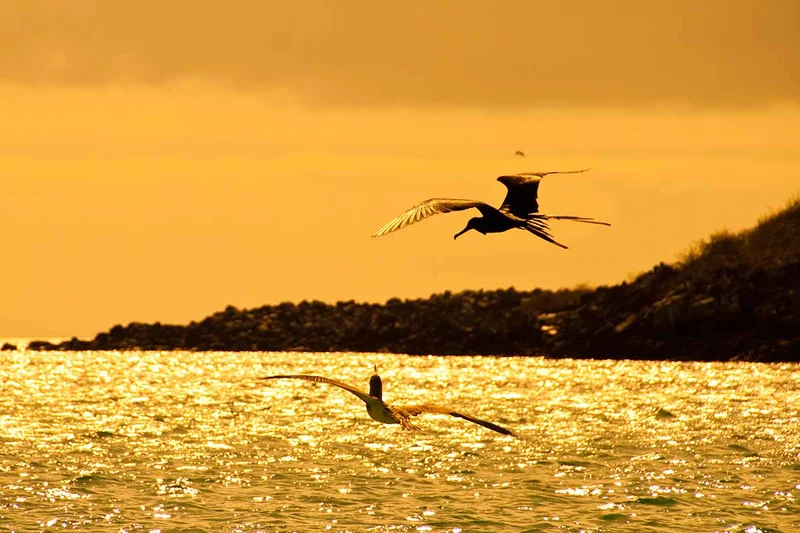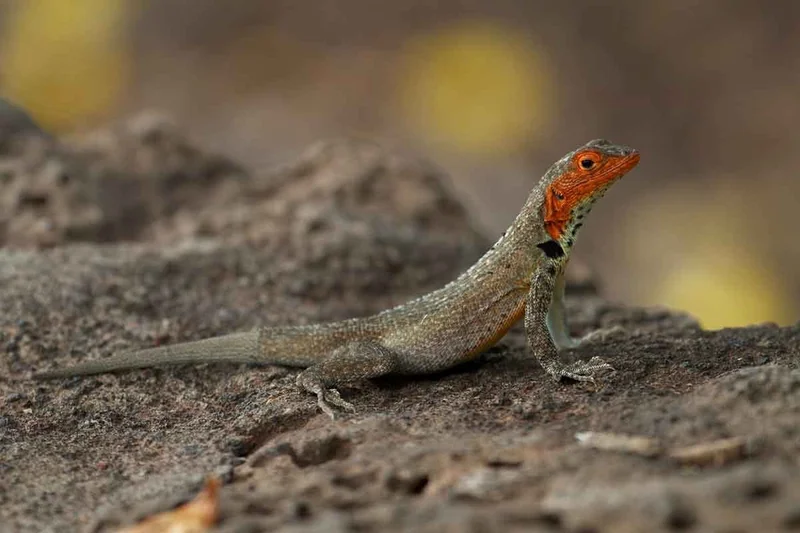
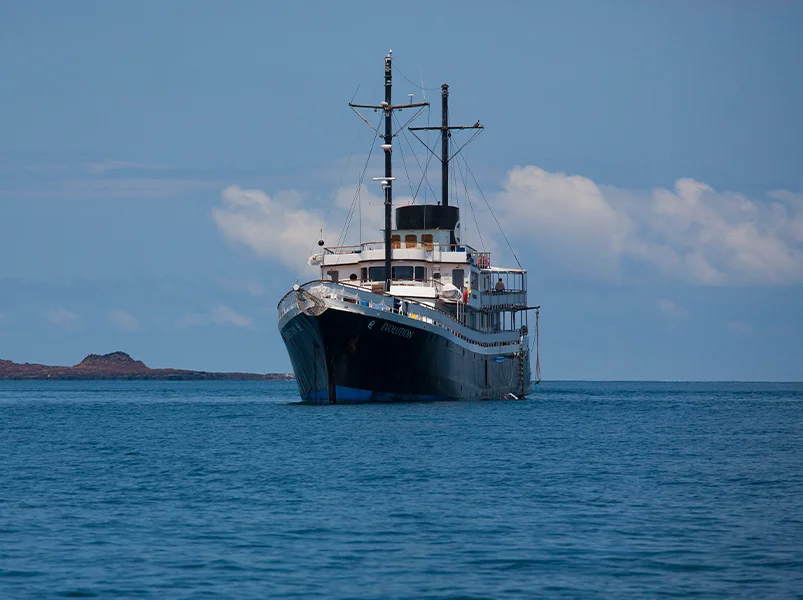
Explore the Galápagos Islands on an 8-day adventure that showcases volcanic landscapes, diverse wildlife, and pristine beaches. Highlights include snorkeling with sea turtles and penguins at Punta Vicente Roca, hiking to Bartolome Island’s summit, spotting albatrosses at Española Island, and observing giant tortoises in the wild. Finish with a visit to the Interpretation Center in San Cristóbal to learn about the islands’ unique ecosystems.
8 Day Galapagos Itinerary
Day 1: Baltra Airport & Daphne Major Islet
This morning we fly to Baltra Island in the Galapagos. Flight time is just under 2 hours from the mainland. }
Daphne Major Islet
Upon arrival we board M/Y Evolution where you will have lunch and a quick briefing en route to our first visitor site: Daphne Major Islet.
We will circumnavigate Daphne Major Islet which is home to a variety of birds including Galapagos martins, blue footed boobies, nazca boobies, short eared owls, red billed tropic birds amongst others. (lunch, dinner)
Day 2: Isabela Island: Punta Vicente Roca & Fernandina Island:Punta Espinoza
Isabela Island: Punta Vicente Roca
In the morning we visit Punta Vicente Roca on Isabela Island. Snorkeling is incredible here as a result of the nutrient-rich waters of the Humboldt Current that bathe the western side of the archipelago. We will have a chance to see colorful fish, sea lions, penguins and sea turtles in the water.
Fernandina Island: Punta Espinoza
Afternoon visit to Fernandina Island, home to La Cumbre volcano, which erupts frequently (most recently in May 2005). We visit Punta Espinoza, a narrow spit of land, where a number of unique species, such as flightless cormorants, marine iguanas, sea turtles, Galapagos Penguins and Galapagos hawks can be seen in close proximity. (breakfast, lunch, dinner)
Day 3: Isabela Island: Urbina Bay & Tagus Cove
Urbina Bay
Urbina Bay is directly west of Isabela’s Volcano Alcedo, where we will make an easy, wet landing (a hop into a few inches of water). We walk on a stretch of three miles (5 km) of the marine reef that has been uplifted by as much as 13 feet (4 meters) out of the water. A highlight of this excursion are the giant land iguanas and giant tortoises, as well as the opportunity to go snorkeling amongst marine creatures, or just relaxing on shore.
Tagus Cove
In the afternoon we visit Tagus Cove on Isabela Island. A wooden stairway rises to the trail entrance and continues around Darwin Lake through a dry vegetation zone, and ends in a promontory formed by spatter cones. The site provides spectacular views of our anchorage in the bay, as well as Darwin and Wolf Volcanoes. The green algae underwater pastures of the cove offer the chance to snorkel with marine iguanas, sea turtles, penguins and sea horses. (breakfast, lunch, dinner)
Day 4: Bartolome Island: Pinnacle Rock & Santiago Island: Sullivan Bay
Bartolome Island: Pinnacle Rock
In the morning we visit Bartolome Island, famous for Pinnacle Rock, where we will see Galapagos Penguins and sea lions. We will also hike a trail to Bartolome’s summit where you will be rewarded with spectacular views of Pinnacle Rock and our beach, where the crystal blue waters of the bay cradle your yacht.
Santiago Island: Sullivan Bay
Afternoon visit to Sullivan Bay, one of the most outstanding volcanic sites in the Galapagos. In the nearly 100 years since the Sullivan Bay Flow, only a few plants like Mollugo and Lava cacti have managed to take root in this harsh environment. Oystercatchers can be seen fishing for crabs and mollusks in the tide pools of Sullivan Bay. After exploring the lava flow, there is swimming and snorkeling with playful sea lions off two small coraline beaches. relaxing on shore.(breakfast, lunch, dinner)
Day 5: Santa Cruz Island: Bachas Beach & Rabida Island
Santa Cruz: Bachas Beach
In the morning we visit Las Bachas, a sandy white-coral beach that is a major egg-laying site for sea turtles. The name Bachas refers to the remains of landing craft left here at the end of WWII. Ashore marine iguanas mingle with flamingos and other wading birds in another of the many super saline lagoons found in the Galapagos.
Rabida Island
Rabida Island, commonly known by its English name of Jervis, is unique for the very red color of the beach and cliffs, beneath which one can find gliding sea turtles and perched blue footed boobies. A thick forest of Palo Santo trees sits back from the beach sheltering a yellow saltwater lagoon. Pelicans next in the thickets and brightly colored pink flamingoes graze the lagoon. A sea lion colony likes to laze on the red sands of the beach. We hike up a tiny peninsula for a wonderful view of the beach and lagoon. Sea caves invite exploration further down the coast. (breakfast, lunch, dinner)
Day 6: Santa Cruz Island: Highlands & Charles Darwin Research Station
Charles Darwin Research Station
Santa Cruz is the second largest island in the Galapagos and its capital, Puerto Ayora, is the economic center of the Islands. In the morning we visit the Charles Darwin Research Station to visit the Giant Tortoise and Land Iguana Breeding and Rearing Program. Here we used to find Lonesome George (now deceased), the last of his particular race of tortoise.
Highlands
Afternoon visit to the Highlands, where the dry coastal vegetation transitions to lush wet fields and forests overgrown with moss and lichens. Our destination is the Tortoise Reserve, where we will have chances see these animals in the wild. (breakfast, lunch, dinner)
Day 7: Española Island: Punta Suarez & Gardner Bay
Punta Suarez
Española, also known as Hood, is the southernmost island of the archipelago, and is one of the most popular due to the breathtaking variation and number of fauna that inhabit the island. In the morning we visit Punta Suarez where you will witness the largest variety of marine iguanas in the Galapagos, masked boobies and blue footed boobies nesting along the cliff’s edge, as well as the nesting site of the famous waved albatross.
Gardner Bay
In the afternoon we visit Gardner Bay, a magnificent long white sandy beach, where colonies of sea lions laze in the sun, sea turtles swim offshore, and inquisitive mockingbirds boldly investigate new arrivals. (breakfast, lunch, dinner)
Day 8: San Cristobal Island: Interpretation Center
Today our Galapagos cruise comes to an end, but before we bid farewell to the Evolution and her crew we pay a visit to the Galapagos National Park Visitor Centre on San Cristobal Island. The Centre presents a comprehensive exhibit of the islands’ natural history, human interaction, ecosystems, flora & fauna and your naturalist will use the exhibits to provide an illustrated overview of life on the Island.
A short trail arrives at Frigate Bird Hill, where both “magnificent-frigates” and “great-frigates” can be seen in the same colony. Next we return to the airport where we began our journey in the Galapagos for the flight back to the Ecuadorian mainland. (breakfast)
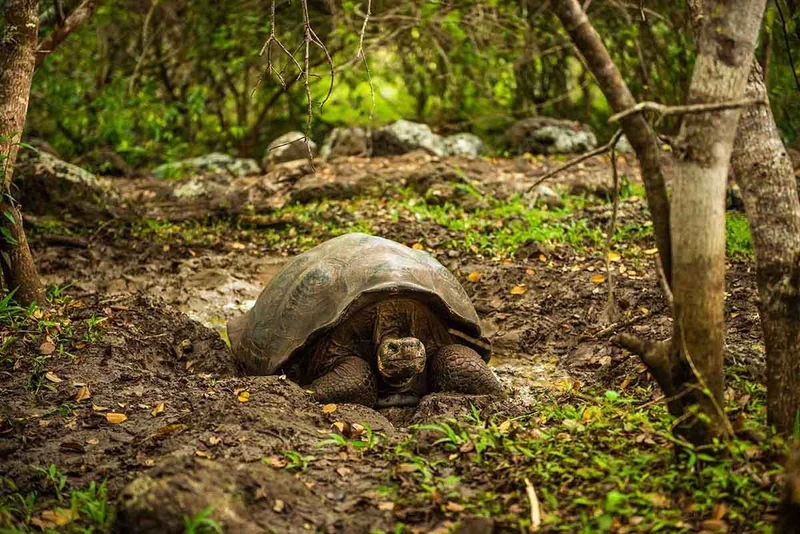

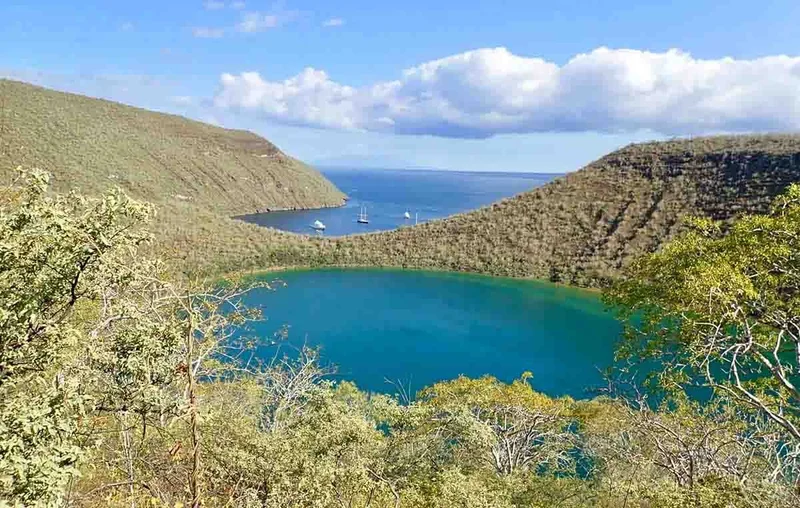
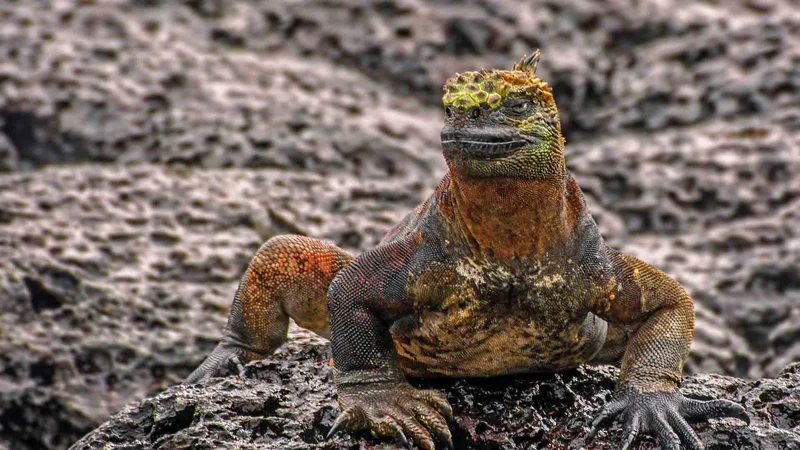
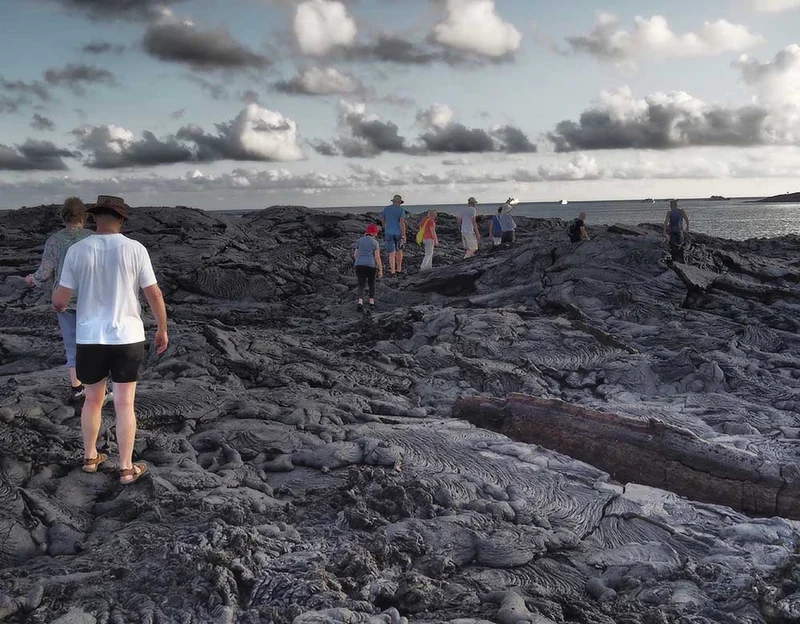



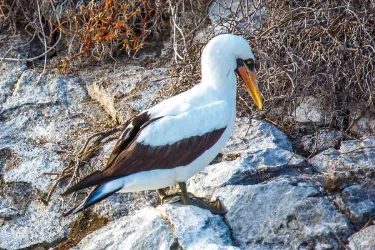


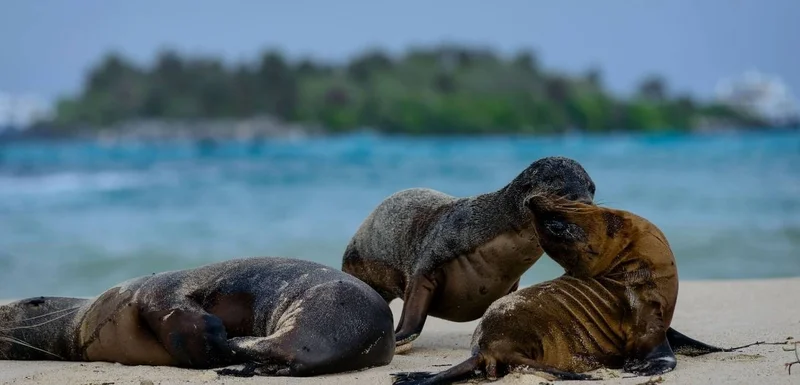
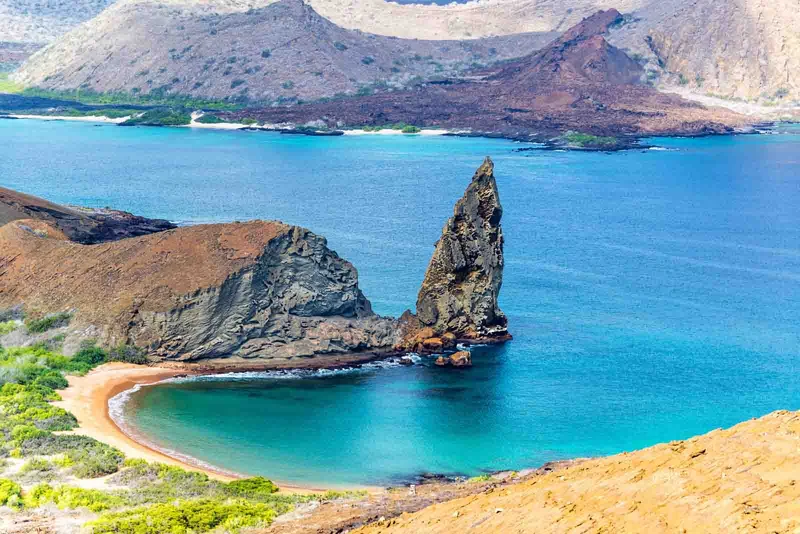

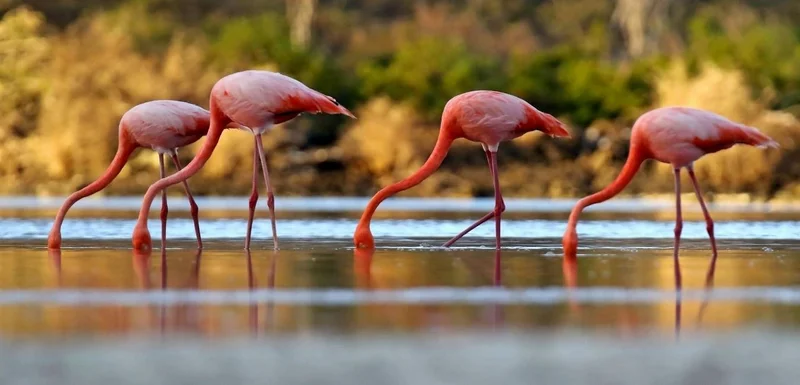
8 Day Galapagos Itinerary Includes
- Comprehensive pre- and post-cruise information material
- Daily buffet breakfast and lunch offering a wide choice of dishes
- Daily served dinner offering a choice of two main courses cruise
- Guides & activities throughout the cruise
- All transfers (with rest of group) while in
- Galapagos
- Soft drinks, juice, coffee, chocolate, water and tea throughout the cruise
- Lectures and entertainment on board
- Snorkeling equipment & wetsuits (shorties)
- Kayaks and equipment
8 Day Galapagos Itinerary Does not Include
- Flights, accomodations, meals, excursions and transfers other than those included in the itinerary
- Galapagos National Park Entrance Fee - $200 USD
- Ingala Transit Control Card - $20 USD
- Beverages purchased at the ship’s bar (all-inclusive packages available)
- Gratuities to guides, crew and staff
- Extra expenses (communication, laundry, souvenirs, etc.)
- Personal travel insurance
8 Day Galapagos Itinerary Highlights
- Sail around Daphne Major to observe large bird colonies.
- Observe unique endemic wildlife at Espinoza Point.
- Snorkel in an uplifted reek at Urbina Bay to discover marine marvels.
- Snorkel with penguins in the volcanic waters of Sullivan Bay.
- Charming pink flamingos and land-iguanas at white-sand Bachas Beach.
- See the famous waved albatrosses at Suarez Point.
Itinerary Map

Reviews
Animals you might see on this itinerary:
More information about the Galapagos Islands you visit in this 8 day itinerary:
Western Galapagos Journey 8-Day Cruise from Baltra - Evolution Yacht
Why travel with us?
Similar Itineraries


